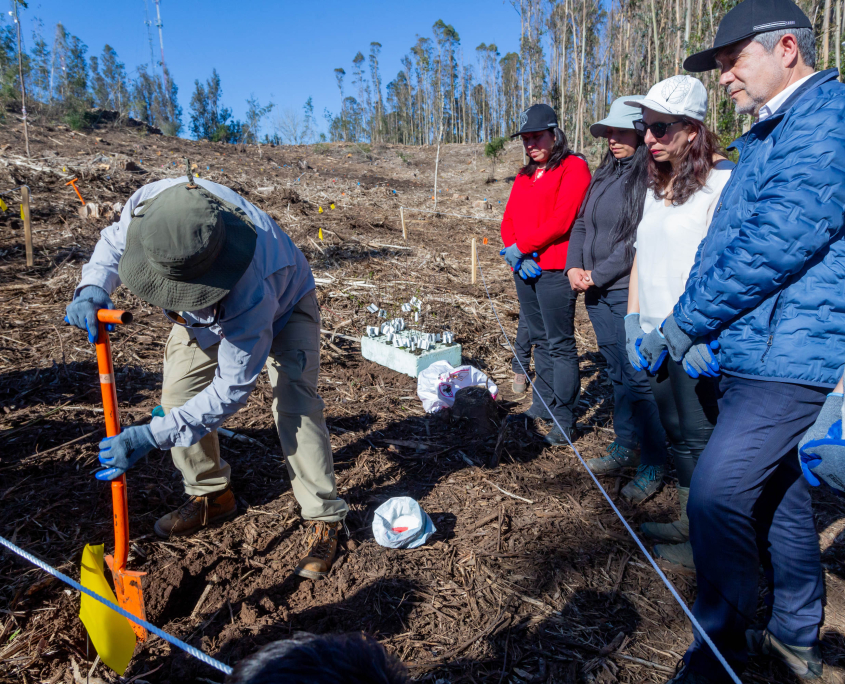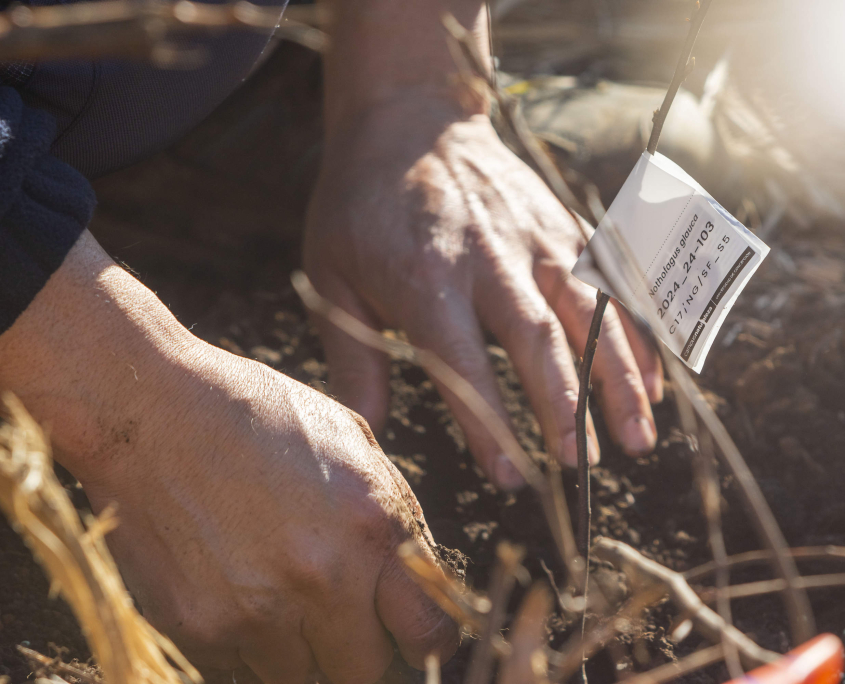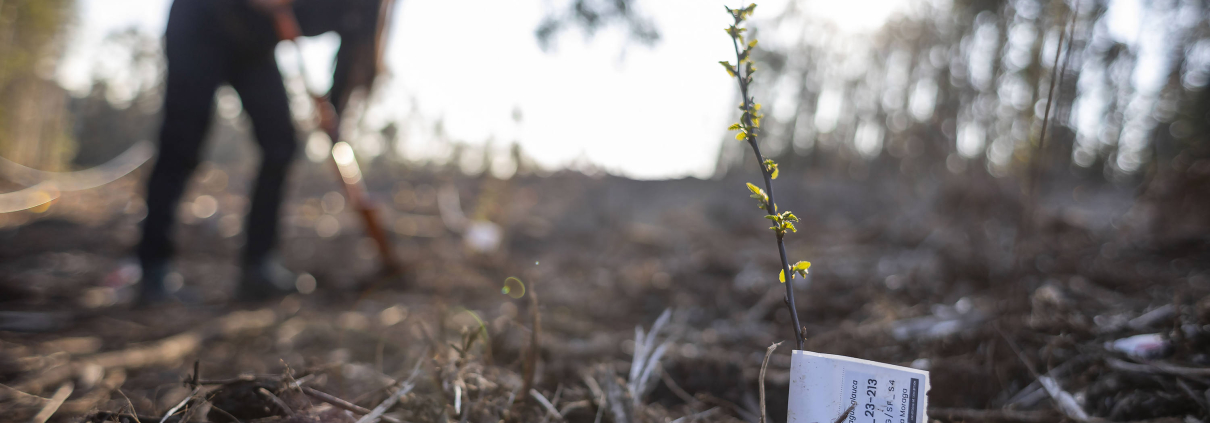Planting with endangered species marks the beginning of the future UdeC botanical garden
University authorities led the planting activities of three species of Nothofagus endangered and endemic to Chile. This milestone inaugurates the ex situ conservation line of the Campus Naturaleza project and future botanical garden of the University of Concepción.
The ruil (Nothofagus alessandrii), hualo (N. glauca) and Santiago oak (N. macrocarpa), Nothofagus tree species that are endangered and endemic to Chile, were the protagonists of the planting days, which begin the first ex-situ collection for the future UdeC botanical garden. The activities were headed by the Rector of the University of Concepción, Dr. Carlos Saavedra Rubilar, the Vice-Rector Dr. Paulina Rincón González, the Vice-Rector for Economic and Administrative Affairs, Dr. Miguel Quiroga Suazo, the Vice-Rector for Institutional Relations and Outreach, Dr. Ximena Gauché Marchetti and the Director of the UdeC Campus Naturaleza project, Dr. Cristian Echeverría Leal.
Ex-situ conservation (conserving species outside their natural range of distribution) is one of the lines of action of the Campus Naturaleza UdeC project, whose objective is to contribute to the persistence of these three species, which are key to the ecology of forests in the southern hemisphere. Currently, they show a worrying tendency towards disappearance in their natural habitats as a result of overexploitation, change in land use, fires and climate change, among other factors.
The Rector, Dr. Carlos Saavedra Rubilar, said that “this is a very symbolic act for the University, for the city and the country, in the sense of this effort that is being made to develop a bio-socio-cultural legacy. First of all, biodiversity in Chile will be protected, in this case of three species of Nothofagus that are threatened in the center of the country. With this possibility, we will allow their permanence over time; there will be 3,000 plants this year, 3,000 next year, which will cover at least 6 hectares and will give people the possibility to learn about these species in the coming years, to learn, but at the same time immersed in a space for research and training processes, where our students accompany the development and naturally the link in teaching.”
“Every time we approach these projects, we know the importance of this being more than conservation, but also a search for the functionality of the forest and how biodiversity is then enriched by this plantation. We are very pleased as a University, very pleased and also grateful for the international collaboration that is present in this project, seeking to protect national biodiversity,” adds the Rector.
In a similar vein, the Vice-Rector for Economic and Administrative Affairs, Dr. Miguel Quiroga Suazo, institutional sponsor of the project, states that “Campus Naturaleza has enormous value, not only for the University, but also as a legacy to future generations. It will allow us to show that it is possible to develop and enhance our missionary work, generating knowledge and training, while preserving and conserving unique spaces that still remain from the ancient deciduous forest of Concepción and its biodiversity, which will also be available for the community to enjoy.”
“In this context, ex situ conservation plays a crucial role in the Campus Naturaleza project as a response from the university to climate challenges. This type of conservation involves protecting and maintaining species outside their natural habitat, which is vital when these habitats and species are threatened by climate change, urbanisation, agriculture or deforestation. In addition, it allows the genetic diversity of threatened species to be maintained, making them more resilient to changes in the environment, providing a biological reserve that can be key to their survival. Campus Naturaleza thus becomes a space for scientific research regarding the adaptation of these species to new habitats and climatic conditions,” he concludes.
Likewise, Pedro Ramírez Glade, Director of the Corporación Universidad de Concepción, emphasized that “this activity is of tremendous importance, because a botanical garden is being started here, with the first species of Nothofagus. I believe that the Universidad de Concepción will stand out worldwide in this regard, even more so with species that are only found in Chile and that are threatened. I congratulate those who have conceived, promoted and also made the beginning of this initiative a reality,” he emphasized.
The University of Concepción has allocated 6 hectares for the implementation of the future botanical garden. This territory was previously covered by a forest plantation of exotic eucalyptus trees, for which 3 hectares of the total were harvested between April and July of this year.

Ex situ conservation
The Nothofagus genus includes 37 species distributed across 7 countries in the southern hemisphere. In Chile, the species ruil (Nothofagus alessandrii), hualo (N. glauca), and Santiago oak (N. macrocarpa) grow between the Metropolitan and Biobío regions, where they are showing a worrying tendency toward extinction, according to Dr. Cristian Echeverría Leal, Director of the UdeC Campus Naturaleza project. “There is growing concern about the loss of biodiversity and the effects of climate change on our planet’s ecosystems. The Chilean context presents a critical scenario for the conservation of biodiversity. Urban pressure, deforestation, and climate change have seriously affected our ecosystems, especially the deciduous forests of south-central Chile. For this reason, there are mechanisms for the conservation of endangered species, with ex situ conservation being a fundamental modality, which arises from a deep vocation for the conservation of biodiversity and the commitment to sustainable development.”
“The first ex situ collection represents a significant step towards the implementation of the future UdeC botanical garden; with it, the University takes a step forward in the protection of these emblematic species,” says the academic, adding that the genus, also known as “roble,” grows only in southern Chile and Argentina. “Of the 10 species of Nothofagus that exist in South America, three species are threatened and are only found in Chile.”
The experience of planting a tree
Tatiana Bustamante Betancourt, who works at the Faculty of Engineering, says that “the experience of planting a tree is something I have wanted to do for a long time. In fact, it was something curious, because at lunch with my colleagues I told them that I wanted to plant a tree and the next day the invitation email arrived. For this reason, I consider it a gift from the University, which allows me to be here for this activity. I am very happy about it. In addition, the idea of following up not only on the little tree we planted, but on the entire project in general, seems to me to be a wonderful initiative to contribute, not only to society, but to the planet.”
Meanwhile, Vanessa Rojas Flores is sure that the botanical garden initiative also involves planting a culture. The Translation and Interpretation student from the Faculty of Humanities and Arts at UdeC says that it is “quite gratifying and a novelty for me, since my career is quite far from the subject of ecosystems and the environment. So it was quite pleasant to participate and know that in a few years this will be a beautiful garden, where people will be able to learn about, admire and also enjoy nature for a while, which is quite important. I even knew that this environment was populated by forests, but I had never had access here,” she confesses.
The Campus Naturaleza project of Universidad de Concepción is an unprecedented initiative in our country. Based on science and community involvement, the Casa de Estudios Penquista proposes a new interaction between humans and nature, comprehensively addressing in situ and ex situ conservation, ecological restoration, biocultural education and comprehensive human health.




